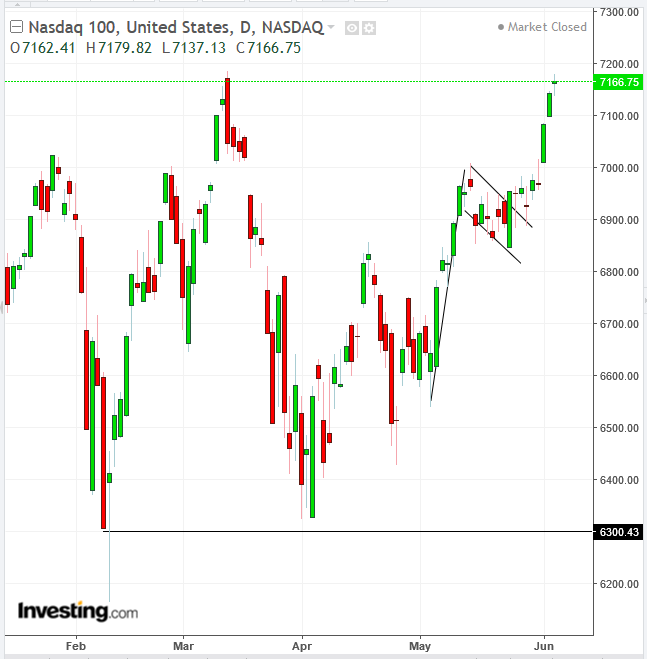After the NASDAQ indices as well as the Russell 2000 yesterday posted fresh highs, should we expect the uptrend since 2016 to resume?
Tech stocks lifted the indices, sending the NASDAQ Composite and NASDAQ 100 to their first records since mid-March. Yesterday’s fresh highs followed the second double-digit correction this year, the first since December 2015.
As well, the Russell 2000 hit its ninth record since the mid-March correction.
From a technical analysis perspective, at this point some traders might cite Charles Dow's confirmation principle, arguing that the NASDAQ’s fresh record confirms those earlier made by the Russell, suggesting continued rallies for all. Co-founder of the Wall Street Journal and formulator of the Dow Indexes, Charles Dow applied the confirmation theory to the Dow Jones Transportation Average and the Dow Jones Industrial Average, arguing that if business is good for industrials, it should be reflected in the transport of the goods as well as in their sales.
While some have applied the confirmation theory to two modern, major indexes, it's difficult to make the case for a confirmation of the rally when the two biggest indices, the S&P 500 and Dow Jones have yet to make their own new highs.

As well, the NASDAQ Composite barely passed its previous high, with a small unimpressive candle while the NASDAQ 100 formed a High Wave candle—demonstrating uncertainty and lack of leadership—below the mid-March all-time-high (the previously mentioned new record was referring to the closing price, not the highest price).
Investors might be holding on to some cash reserves since they're surrounded by threats, right now the newly formed euroskeptic government coalition in Italy. The political uncertainty there led to a selloff for Italian bonds last week, which spread to global markets.
Once the coalition was established last Friday, investors ended the selloff. Today, however, Italian bonds are falling once again, after the new Italian Prime Minister Giuseppe Conte said in his inaugural speech that an Italiexit has not been discussed. However, he didn’t add that it’s not something the populist coalition would entertain. Moreover, the speech included Trump-like rhetoric of a “revolutionary” agenda that would even the playing field for Italy with the rest of Europe. That contrarian approach to Europe—even if justified—does in fact pave the way for a euro exit.
Obviously, with this particular geopolitical risk factor back on the table, US indices could potentially head lower today. Which may provide some openings for dip buyers.
While we're exercising caution, we are not suggesting traders shouldn’t take advantage of opportunities. With regard to the NASDAQ 100, if today’s trading session finishes lower than yesterday’s close, and certainly if it ends below yesterday's low, the NDX might begin a pullback to the bullish falling flag. Should that fail to support prices, it might become the staging of a double top, signaling a longer-term price reversal.
Trading Strategies
Conservative traders would want to wait for a full return move to the falling flag and confirmation of its integrity, with at least one long green candle engulfing the preceding red candle.
Moderate traders may wait for a return move to the 7,000 level, the highest point of the flag, for a closer entry, but not necessarily for proof of integrity.
Aggressive traders may short, with a stop-loss above the 7,180 level, the top of the high wave candle.
